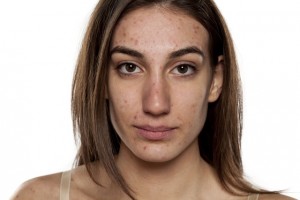 I regularly hear women with acne say “everything gets worse around my cycle. I dread that time of the month’. Breakouts, deeper cystic acne, oily skin, redness and congestion can all be part of this picture. If you feel this way, you aren’t alone, close to ¾ of women experience worse acne breakouts in the lead up to the period. However it is highly likely that out of balance hormones aren’t actually the issue. Certainly they might be part of the problem but focusing on hormones alone rarely leads to lasting improvements in acne. And as experienced by many women who want clear skin there comes a time when being on the oral contraceptive pill or more serious acne medications such as roaccutane no longer helps. So if the cause isn’t hormones then what is? In both men and women worsening acne and severe breakouts are more closely linked to changes in a protein called insulin-like growth factor-1 (IGF-1) than they are to hormonal changes. This article looks at the influence of IGF-1 on acne and what in-turn drives this to cause havoc with our skin. It also addresses how to improve this key underlying cause of acne instead of chasing ‘perfect’ hormones. Levels of IGF-1 are elevated in teens and decline with adulthood. Of course not all teens develop acne and some adults do so there must be other factors that drive up the levels of IGF-1 in the body. Highly significant is the relationship between Western dietary patterns and acne. Certain foods drive up IGF-1 encouraging the development of acne. Research has shown that teens eating a non-Western dietary pattern are less likely to develop acne and have lower levels of IGF-1 but what of adults with acne? Diet alone can drive up IGF-1 levels however, there are also some conditions such as poly-cystic ovarian disease (PCOS), obesity and insulin resistance that also push levels up thus creating the conditions in adults who are past puberty are more likely to develop acne. Three major food groups are the most significant promoters of IGF-1:
I regularly hear women with acne say “everything gets worse around my cycle. I dread that time of the month’. Breakouts, deeper cystic acne, oily skin, redness and congestion can all be part of this picture. If you feel this way, you aren’t alone, close to ¾ of women experience worse acne breakouts in the lead up to the period. However it is highly likely that out of balance hormones aren’t actually the issue. Certainly they might be part of the problem but focusing on hormones alone rarely leads to lasting improvements in acne. And as experienced by many women who want clear skin there comes a time when being on the oral contraceptive pill or more serious acne medications such as roaccutane no longer helps. So if the cause isn’t hormones then what is? In both men and women worsening acne and severe breakouts are more closely linked to changes in a protein called insulin-like growth factor-1 (IGF-1) than they are to hormonal changes. This article looks at the influence of IGF-1 on acne and what in-turn drives this to cause havoc with our skin. It also addresses how to improve this key underlying cause of acne instead of chasing ‘perfect’ hormones. Levels of IGF-1 are elevated in teens and decline with adulthood. Of course not all teens develop acne and some adults do so there must be other factors that drive up the levels of IGF-1 in the body. Highly significant is the relationship between Western dietary patterns and acne. Certain foods drive up IGF-1 encouraging the development of acne. Research has shown that teens eating a non-Western dietary pattern are less likely to develop acne and have lower levels of IGF-1 but what of adults with acne? Diet alone can drive up IGF-1 levels however, there are also some conditions such as poly-cystic ovarian disease (PCOS), obesity and insulin resistance that also push levels up thus creating the conditions in adults who are past puberty are more likely to develop acne. Three major food groups are the most significant promoters of IGF-1:
- high glycaemic foods (sugars and processed carbohydrates)
- milk and dairy
- saturated fats including trans-fats and fats deficient in omega 3 polyunsaturated fats (PUFAs).
These dietary factors lead to increased sebum production and changes in composition providing a perfect breeding ground for a normal skin bacteria called propionibacterian acnes (P. acnes). In a high sebum environment P. acnes overgrows and forms a biofilm (a biofilm is a safe home for bacteria akin to the brick house in the Three Little Pigs). The biofilm makes it harder to eradicate or reduce the level of P. acnes with topical products. As well as higher levels, changes to the composition of sebum means it functions as a ‘danger signal’ stimulating inflammation allowing the P. acnes to adhere more strongly to the skin. It also increasing the growth of the skin cells which cause pore blockage. These factors are the drivers of acne. Rises in IGF-1 do impact on hormones, particularly androgens such as testosterone and certainly they have a role in acne. While IGF-1 leads to small increases in systemic hormones the more significant impact relates to local skin effects. Specifically the rises in IGF-1:
- Amplify the androgen (testosterone and DHEA) metabolism in the skin, which has a local effect further promoting increased sebum and acne
- Increases in facial sebum excretion
- Increases skin cell proliferation, which then blocks pores and
- Stimulates local skin inflammation
Back to diet and its role in IGF-1 production: a Western dietary pattern high in high glycaemic foods and diary increases serum IGF-1 and is also linked with conditions such as PCOS and diabetes type 2, which further increase IGF-1. High glycaemic diets, which include processed foods and sugars, soft drink and diary are significantly linked to higher acne incidence, seen in up to 79-95% of the adolescent population in Westernised countries. By contrast non-Western diets, which are traditionally low glycemic do not have the same association. Diet can be a significant treatment approach in acne as shown in an Australian trial conducted by RMIT in Melbourne where a low glycaemic index, higher vegetable and protein diet was shown to improve symptoms of acne including a reduced number of facial lesions, reduced androgen and IGF-1 levels and improved insulin sensitivity. In clinical practice I recommend a low glycaemic diet for those with acne. It is also quite common for me to suggest a period (up to 5 weeks) of dairy avoidance. The association between milk and acne is independent of high glycaemic foods and extensively studied in over 10 thousand teens. The research shows:
- Milk consumption alone doesn’t cause acne but it seems that those that drink milk develop more severe acne than non-milk drinkers. Furthermore, the more milk consumed, the worse the acne tended to be.
- The link between the severity of acne and milk is strongest, however other dairy products have shown similar effects including cottage cheese, chocolate milk and skim milk.
- One of the interesting things that emerged from the research is that skim milk induced more breakouts than whole fat milk indicating that fat is not the issue.
So if not the fat, what is the culprit? As mentioned above cow’s milk both contains and is a promoter or IGF-1 and high milk consumption is associated with a 20-30% rise in circulating levels in teens. In adults the rise is 10-20%. Dairy products (except for cheese) also promote rises in insulin, a factor that compounds the impact of IGF-1 and further drives sebum production, inflammation and acne development. There are many different proteins in milk and IGF-1 is only one that may cause issues. The other issue that may be linked to dairy is the casein and whey proteins found in cow’s milk. Casein is approximately 80% of the protein and whey makes up the remaining 20%. Casein is the factor that drives up serum IGF-1, whereas whey increases fasting insulin both of which promote the development of acne. So while milk and dairy are not a direct cause of acne, cutting it out of your diet can help to reduce acne severity. A note of caution, often when people give up cow’s milk, they move over to soy milk. While this may seem like a sensible substitute, soy contains phytoestrogens, which may also be problematic for acne sufferers. Unfortunately, goat and sheep milk may not be good alternatives either, as the proteins are very similar to cow’s milk and may have a similar effect on digestion. It is best just to see how you go without cow’s milk first before using a dairy substitute.
Ananda has a special interest in working with clients that have acne and runs a Healthy Skin Program, which will help you to:
- Have clear, healthy skin
- Be able to see and track clear improvement over a 6 month period
- Experience improved wellbeing and overall health
- Understand what underlying causes impact your skin and know how to manage them
- Know what foods support your skin, and those that don’t
- Have an individual at-home care program that suits your skin
- Know what topical products suit your skin and how to choose them
- Have mindfulness and self-care strategies in place to support your overall health
For more info or to book phone us on (07) 3366 7970 or online anytime at vibenaturalhealth.com.au
References: Melnik, B.C., 2015. Linking diet to acne metabolomics, inflammation, and comedogenesis: an update. Clinical, cosmetic and investigational dermatology, 8, p.371. Melnik, B.C. and Schmitz, G., 2009. Role of insulin, insulin?like growth factor?1, hyperglycaemic food and milk consumption in the pathogenesis of acne vulgaris. Experimental dermatology, 18(10), pp.833-841.
